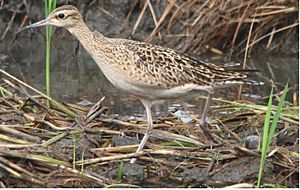Little curlew facts for kids
Quick facts for kids Little curlew |
|
|---|---|
 |
|
| Conservation status | |
| Scientific classification |
The Little Curlew (Numenius minutus) is a small shorebird. It belongs to a large bird family called Scolopacidae. This tiny curlew makes its home and raises its young in the far northern parts of Siberia. It is a close relative of the Eskimo Curlew, which lives in North America.
What's in a Name?
The name "curlew" sounds like the call of the Eurasian Curlew. It might also come from an old French word, corliu, meaning "messenger." This word was first written down in 1377.
The scientific name for the Little Curlew is Numenius minutus. The word Numenius comes from ancient Greek. It means "new moon" because the bird's curved beak looks like a crescent moon. The word minutus comes from Latin and simply means "small."
What Does It Look Like?
The Little Curlew is mostly grayish-brown. Its belly is white, and its underwings are also grayish-brown. It has a short, curved beak, which is not as long as other curlews.
Its head has a pattern similar to a Eurasian Whimbrel. This means it has stripes on its crown (top of its head) and above its eyes. When it calls, it makes a sound like a repeated whistle.
This bird is the smallest type of curlew. It is about 28 to 31 cm (11 to 12 in) long. Its wingspan is about 68 to 71 cm (27 to 28 in). An average Little Curlew weighs around 175 g (6 oz).
Where Does It Go?
The Little Curlew is a bird that travels a lot. It is a strongly migratory species. During the winter, it flies all the way to Australasia, which includes places like Australia.
Sometimes, a Little Curlew might fly off course. It has been seen a few times in western Europe. For example, one was spotted in Blankenberge, Belgium, in September 2010. Another bird was seen in The Netherlands during the winter of 2019-2020.
Life Cycle and Habits
These birds often breed in groups, but not too close together. They prefer clearings in forests near river valleys. Their nest is a simple scrape on the ground.
In winter, they live inland in grassy areas or near fresh water. Most of them spend winter in northern Australia. Some travel as far south as St Kilda, South Australia. They like to stay in groups and form large flocks.
The Little Curlew finds its food by poking its beak into soft mud. It searches for small creatures without backbones, like worms or insects.


